Related Research Articles
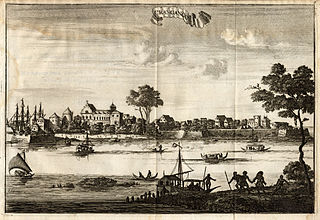
Kodungallur is a historically significant town situated on the banks of river Periyar on the Malabar Coast in Thrissur district of Kerala, India. It is 29 kilometres (18 mi) north of Kochi (Cochin) by National Highway 66 and 38 km (24 mi) from Thrissur. Kodungallur, being a port city at the northern end of the Kerala lagoons, was a strategic entry point for the naval fleets to the extensive Kerala backwaters.

Vypin is one of the group of islands that form part of the city of Kochi (Cochin), in the Indian state of Kerala. Vypin forms a barrier island which lies between the Arabian Sea in the west and the Cochin backwaters formed by the various distributaries of Periyar river, in the east. The northernmost end of the island lies on the estuary of the Periyar river in Muziris (Kodungallur), and the southernmost end in the mouth of the Cochin Backwaters in Kalamukku near Fort Vypin. The island is about 27 kilometres (17 mi) long and is connected to mainland Kochi by a series of bridges known as the Goshree bridges, which start at Kalamukku in Vypin, touch other two islands and then finish at Marine Drive covering a total distance of around three km (1.9 mi). Vypin is 58th most densely populated islands in the world. Njarakkal is one of the most densely populated locations within Vypin.
North Paravur. formerly known as Paravur or Parur, is a municipality and suburb in Ernakulam district in the Indian state of Kerala. It is a northern suburb of the city of Kochi and is situated around 20 km from the city centre. It is also the first place in India to use electronic voting machine during the by-elections in 1982.
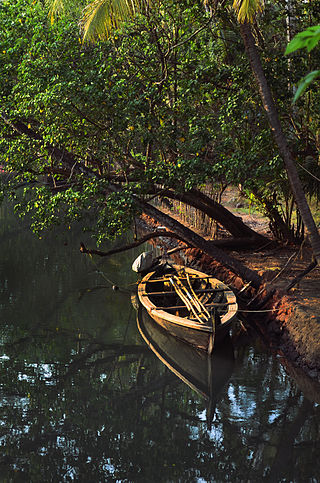
Azhikode is a coastal village in Thrissur district of Kerala, India. The nearest towns are Kodungallur and Paravoor. Azikode is a part of Kodungallur taluk. Azhikode has a beach known as the munakkal beach. It has got the vast shore stretch around 3 km along the main beach side. It is the main attraction of this village. The main economic activity is fishing.
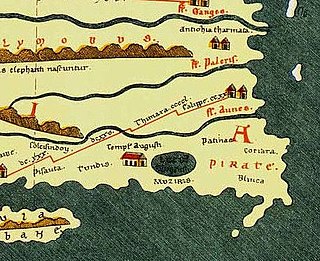
Muchiri (മുച്ചിരി), commonly anglicized as Muziris was an ancient harbour and an urban centre on the Malabar Coast. Muziris found mention in the Periplus of the Erythraean Sea, the bardic Tamil poems and a number of classical sources. Situated somewhere around the present day Kodungallur, the exact location of Muziris has been a matter of dispute among historians and archaeologists. However, excavations since 2004 at Pattanam, near North Paravur, have led to some experts suggesting that the city was located there.

Pattanam is a village located in the Ernakulam District in the southern Indian state of Kerala. It is located 2 km north of North Paravur, 6 km and East of Chendamangalam 25 km north of Kochi (Cochin).

Thrissur is the administrative capital of Thrissur District, in the central part of Kerala state, India. Thrissur district was formed on 1 July 1949. It is an important cultural centre, and is known as the Cultural Capital of Kerala. It is famous for the Thrissur Pooram festival, one of the most colourful and spectacular temple festival of Kerala. From ancient times, Thrissur has been politically, economically and culturally significant to the Indian subcontinent. It has opened the gates for Arabs, Romans, Portuguese, Dutch and English. According to tradition, Thrissur is where Christianity, Islam and Judaism entered the Indian subcontinent. Local Christian tradition holds that Thomas the Apostle arrived in 52 CE, and Muslim tradition states that Methala is the location of country's first mosque.

Vallikkunnu is a village in Tirurangadi Taluk of Malappuram district in the state of Kerala, India with an area of 25 km2. It is located 5 km north of Parappanangadi town and comes under the jurisdiction of Parappanangadi Police Station and Parappanangadi Judicial First Class Magistrate Court. Its latitude and longitude are 11'07" N and 7'51"E respectively. Vallikkunnu was awarded the best panchayath of Kerala in 1997. Vallikunnu is situated on Tirur-Kadalundi Road. Vallikkunnu is also a part of the Oldest Railway Line of Kerala laid in 1861 from Tirur to Chaliyam via Tanur, Parappanangadi, Vallikkunnu, and Kadalundi.

Kadalundi is a village in Kozhikode district, Kerala, India. It is a coastal village close to the Arabian Sea. Kadalundi is famous for its bird sanctuary, which is home to various migratory birds during certain seasons and has been recently declared as a bio-reserve. The Kadalundi-Vallikkunnu community reserve is the first community reserve in Kerala. The Kadalundi River and the Chaliyar river, two of the longest rivers of Kerala, merges with the Arabian Sea at Kadalundi. The first railway line in Kerala was laid in 1861 from Tirur to Chaliyam through Tanur, Parappanangadi, Vallikkunnu, and Kadalundi.

Tyndis was an ancient Indian seaport/harbor-town mentioned in the Graeco-Roman writings. According to the Periplus of the Erythraean Sea, Tyndis was located north of port Muziris in the country of the Cerobothra.
Nelcynda is a place in ancient Kerala. It was described in Pliny's classical work The Natural History as well as in Periplus of the Erythraean Sea. It was believed to be the capital of the Ay kingdom. Nakkada near Niranam in Pathanamthitta district are often identified with Nelcynda.

The Mala Synagogue is one of the oldest extant synagogues in India and was built by the historic Malabar Jews of Kerala. It is located at Mala, a small town in Thrissur district of Kerala state in south India.
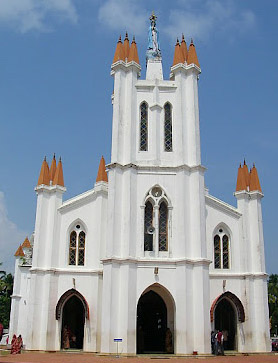
The Basilica of Our Lady of Snow, Pallippuram, Ernakulam, Kerala, is a minor basilica. The basilica decree was issued on 27 August 2012. The raising of the Pallippuram church was officially announced at the conclusion of the silver jubilee celebrations of the diocese on 7 October.

Pizhala is an island near Kochi surrounded by river Periyar. It is the central part and Capital of Kadamakkudy Grama Panchyath, Kanayannur Taluk, Ernakulam District in the Indian state of Kerala. The name Pizhala is derived from the Portuguese words paz na ilha, which mean 'peace on island'. Pizhala island was formed naturally due to the great floods of Periyar in 1341 AD, which choked the Muziris Port, one of the greatest ports in Ancient World.
The Great flood of '99 (Malayalam:'തൊണ്ണൂറ്റി ഒമ്പതിലെ വെള്ളപ്പൊക്കം' occurred when the Periyar River in Kerala state of India flooded in the month of July 1924. This happened in the year 1099 ME in the Malayalam Calendar. As the Malayalam Calendar was popular in Kerala, the flood is generally referred to as "The Great flood of "99".The rain continued for about three weeks. Many districts of present-day Kerala were deeply submerged by the flood - from Thrissur, to Ernakulam to Idukki, Kottayam even up to Alappuzha and Kuttanad. A huge mountain called Karinthiri Mala was washed away by this flood and the road to Munnar also went along with it. As the road to Munnar was lost by this flood, a new road from Ernakulam to Munnar became necessary - the present day road from Ernakulam to Munnar was constructed after this. Kundala Valley Railway which was the first monorail system in India was also completely destroyed. Various remnants of the old Railway systems still exist at Munnar.
Thrissur is a district of Kerala situated in the central part of that state in South India. Spanning an area of about 3,032 km2 (1,171 sq mi), Thrissur district is home to over 9% of Kerala's population.
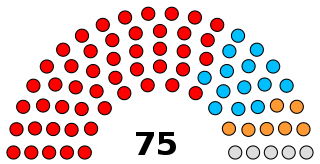
The Kozhikode Corporation, is the municipal corporation that administers the city of Kozhikode (Calicut), Kerala. Established in 1962, it is in the Kozhikode parliamentary constituency. The first mayor was H. Manjunatha Rao. Its four assembly constituencies are Kozhikode North, Kozhikode South, Beypore and Elathur. The Corporation is headed by a Mayor and council, and manages 118.58 km2 of the city of Kozhikode, with a population of about 609,224 within that area. Kozhikode Municipal Corporation has been formed with functions to improve the infrastructure of town.
The Paravur Synagogue aka Parur Synagogue is one of the largest and most complete among the Jewish synagogues in Kerala, located in North Paravur (Parur). Built by the Malabar Jews, it has undergone successive phases of destruction and reconstruction. The present synagogue complex dates to 1616 A.D., but it was built on top of a much older building speculated to have been constructed as early as 750 A.D or 1105 A.D., making it one of the oldest synagogues in India and the Common Wealth of Nations. It is currently non-operational as a synagogue for worship. It has been renovated by the Government of Kerala and is open to public visits as the Kerala Jews History Museum.
References
- ↑ Anandan, S.; Rajagopal, Shyama (29 September 2018). "Ground Zero | Kerala floods replay the catastrophe that hit the ancient sea port Muziris in 1341". The Hindu. ISSN 0971-751X . Retrieved 9 February 2022.
- ↑ Tom, Disney (27 August 2018). "flood: After centuries, water almost wiped off Muziris remains". The Times of India. Retrieved 9 February 2022.
- ↑ "How Periyar's dance of death changed Kerala's landscape". OnManorama. Retrieved 9 February 2022.